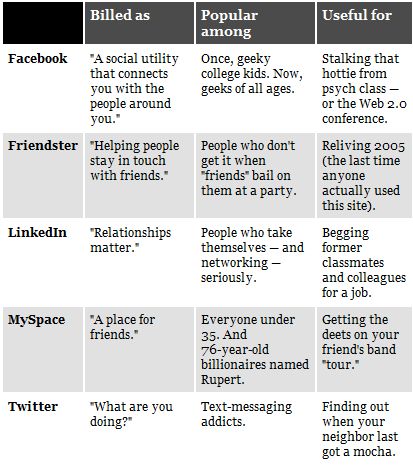Twitter and Youth
Yes, at some point twitter might become mainstream for some purposes. This could be one:
This and other great cartoons of this kind you can find at the SocialSignal Blog.
(via here)
Yes, at some point twitter might become mainstream for some purposes. This could be one:
This and other great cartoons of this kind you can find at the SocialSignal Blog.
(via here)
As I twittered already: I received Joseph Jaffes new book „join the conversation“ today. Much faster than I thought it would take amazon to deliver it. I have already started reading it and sofar it’s good!
Joe utilized all the means of new marketing (conversational marketing!) to produce and promote the book: Bloggers were helping to design the cover, within a wiki everybody could help write chapter 10 (there seems to be a system – chapter 10 was also the „odd one out“ in his last book the chapter being downloadable as an audio file from his website).
There is also a blog for the book, jointheconversation.us. And in true conversational effort, everyone can be an author in this blog (let’s hope that doesn’t become too messy).
Last week Joe managed an amazing coup of „bumrushing“ the amazon charts by asking all his blog readers, podcast listeners and facebook friends to join the „bumrush the charts“ event on facebook.
This basically meant for everyone to buy the book on one single day, so that the collective effort would push the book up the charts at amazon.com. (This is also why I bought the book last Sunday – I was going to get it anyway, so why not take part in that exercise.)
The last result I could see: #2 in business books (behind Alan Greenspan) and #26 overall. Pretty impressive! It dropped down again to lower ranks in the meantime, as one would have expected with a fairly new title, but let’s see where it will get to over time.
FastCompany writes about the way twitter proved to be very useful during the californian fire disaster:
the service is allowing thousands of Southern California residents to stay safe by receiving up-to-the-minute geographical information about the spreading fires. Twitter’s short, instant updates are perfect for bare-bones, factual updates, and and it’s not the only Web service helping out panicked Californians. Several Google Maps mashups have emerged with dynamic blaze information and evacuation details, and a number of blogs are tracking the destruction chronologically to allow people to predict if their homes will stay safe.
People could track the relevant tweet-threads by following keywords such as #sandiegofire. Some relied much more on this source of information (i.e. tweets via mobile decive) than their landline based internet connection, which could have broken down at any time.
This is obviously a tragic example of how twitter can be useful. But nevertheless it shows that there is a lot of potential in this one-to-many sms/microblogging tool.
(via and the email of a colleague)
Wired published a nice little table displaying the main characteristics of the best known social networks:
